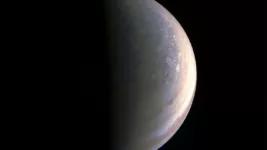After journeying for nearly five years to our solar system’s largest planet, NASA’s Juno spacecraft has sent back the first images of Jupiter’s north pole and the auroras rippling across its southern pole.
The images were taken during the spacecraft’s first flyby of the planet with its instruments switched on, NASA said in a statement on Friday.
Juno successfully executed the first of 36 orbital flybys on 27 August when the spacecraft came about 4,200 kilometres above Jupiter’s swirling clouds.
The images show storm systems and weather activity unlike anything previously seen on any of our solar system’s gas-giant planets, NASA said.

This image provided by NASA provides a new perspective on Jupiter’s south pole, seen when the Juno spacecraft was about 94,500 km away. (Photo: AP)
Scott Bolton, Principal Investigator, Juno
First glimpse of Jupiter’s north pole, and it looks like nothing we have seen or imagined before. It’s bluer in colour up there than other parts of the planet, and there are a lot of storms.
Along with JunoCam snapping pictures during the flyby, all eight of Juno’s science instruments were energised and collecting data.
The Jovian Infrared Auroral Mapper (JIRAM), supplied by the Italian Space Agency, acquired some remarkable images of Jupiter at its north and south polar regions in infrared wavelengths.
“JIRAM is getting under Jupiter’s skin, giving us our first infrared close-ups of the planet,” said Alberto Adriani, JIRAM co-investigator from Istituto di Astrofisica e Planetologia Spaziali, Rome.

This infrared image from Juno provides an unprecedented view of Jupiter’s southern aurora. Such views are not possible from Earth. (Photo: IANS)
“These first infrared views of Jupiter’s north and south poles are revealing warm and hot spots that have never been seen before. And while we knew that the first-ever infrared views of Jupiter’s south pole could reveal the planet’s southern aurora, we were amazed to see it for the first time,” Adriani said.
Alberto Adriani, JIRAM co-investigator from Istituto di Astrofisica e Planetologia Spaziali, Rome.
No other instruments, both from Earth or space, have been able to see the southern aurora. Now, with JIRAM, we see that it appears to be very bright and well-structured. The high level of detail in the images will tell us more about the aurora’s morphology and dynamics.
The Juno spacecraft launched on August 5, 2011, from Cape Canaveral, Florida and arrived at Jupiter on July 4, 2016.








